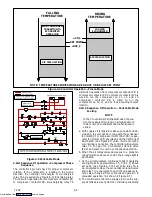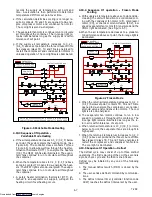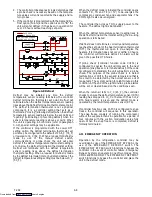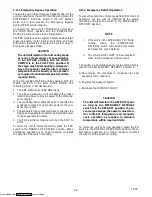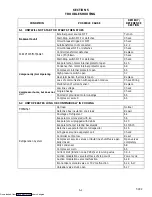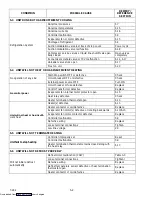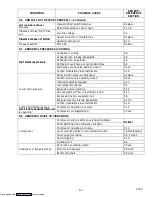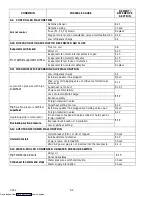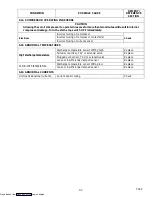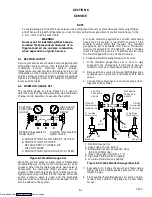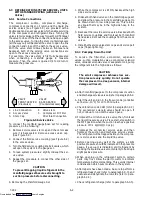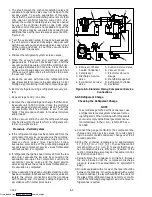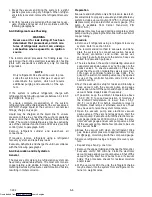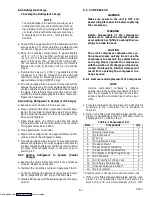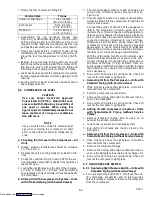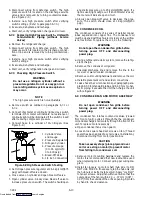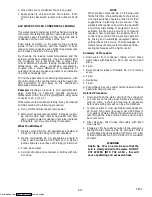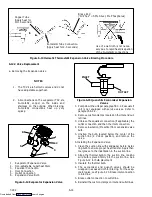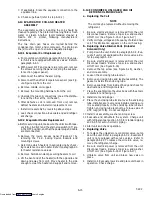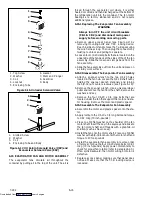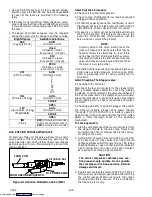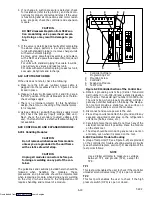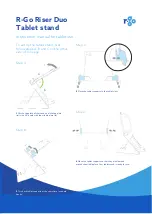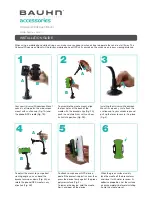
6-6
T-292
c. Break the vacuum and bring the system to a slight
positive pressure using dry nitrogen. When refriger-
ant is fully recovered, remove the refrigerant recovery
unit.
d. Perform repairs as required and then leak test, evac-
uate, charge and reseal unit in accordance with the
following paragraphs.
6.4.3 Refrigerant Leak Checking
WARNING
Never use air for leak testing. It has been
determined that pressurized, air-rich mix-
tures of refrigerants and air can undergo
combustion when exposed to an ignition
source
The recommended procedure for finding leaks in a
system is with a R-134a electronic leak detector. Testing
joints with soapsuds is satisfactory only for locating
large leaks.
NOTE
Only refrigerant 134a should be used to pres-
surize the system. Any other gas or vapor will
contaminate the system, which will require
additional purging and evacuation of the sys-
tem.
If the system is without refrigerant, charge with
refrigerant 134a to build up pressure between 2.1 to 3.5
kg/cm
@
(30 to 50 psig).
To ensure complete pressurization of the system,
refrigerant should be charged at all of the access valves.
DO NOT charge liquid at the suction or economizer
fittings, charge only vapor.
Liquid may be charged at the liquid line. To ensure
pressure to this area, check that the suction modulating
valve is more than 10% open at controller function code
Cd01. The suction modulating valve may be opened by
use of the controller function code Cd41 valve override
control (refer to paragraph 6.20).
Remove refrigerant cylinder and leak-check all
connections.
If required, remove refrigerant using a refrigerant
recovery system and repair any leaks
Evacuate, dehydrate and charge the unit in accordance
with the following paragraphs
6.4.4 Evacuation and Dehydration
General
The presence of moisture in a refrigeration system can
have many undesirable effects. The most common are
copper plating, acid sludge formation, “freezing-up” of
metering devices by free water, and formation of acids,
resulting in metal corrosion.
Preparation
Evacuate and dehydrate only after pressure leak test.
Essential tools to properly evacuate and dehydrate any
system include a vacuum pump (8 m
3
/hr = 5 cfm volume
displacement) and an electronic vacuum gauge. (The
pump is available from Carrier Transicold, P/N
07-00176-11.)
Additional time may be saved during a complete system
pump down by replaceing the filter-drier with a section of
copper tubing.
Procedure
a. Remove all refrigerant using a refrigerant recovery
system. Refer to section 6.4.2.
b. The recommended method to evacuate and dehy-
drate the system is to connect evacuation hoses at
the liquid, economizer and suction access val-
ves.(see Figure 6--6). Be sure the service hoses are
suited for evacuation purposes.
c. The area between the suction modulating valve and
evaporator expansion valve may not be open to the
access valves. To ensure evacuation of this area,
check that the suction modulating valve is more than
10% open at controller function code Cd01. If re-
quired, the suction modulating valve may be opened
by use of the controller function code Cd41 valve
override control.
d. Test the evacuation setup for leaks and drawing a
deep vacuum with the vacuum pump and gauge
valves open. Shut off the pump and check to see if the
vacuum holds. Repair leaks if necessary.
e. If possible, keep the ambient temperature above
15.6
_
C (60
_
F) to speed evaporation of moisture. If
the ambient temperature is lower than 15.6
_
C
(60
_
F), ice might form before moisture removal is
complete. Heat lamps or alternate sources of heat
may be used to raise the system temperature.
f. Open the vacuum pump and electronic vacuum
gauge valves, if they are not already open. Start the
vacuum pump. Evacuate unit until the electronic vac-
uum gauge indicates 2000 microns. Close the elec-
tronic vacuum gauge and vacuum pump valves. Shut
off the vacuum pump. Wait a few minutes to be sure
the vacuum holds.
g. Break the vacuum with clean dry refrigerant 134a
gas. Raise system pressure to approximately 0.2 kg/
cm
@
(2 psig), monitoring it with the compound gauge.
h. Remove refrigerant using a refrigerant recovery sys-
tem.
i. Repeat steps f.and g. one time.
j. Remove the copper tubing and change the filter-drier.
Evacuate unit to 500 microns. Close the electronic
vacuum gauge and vacuum pump valves. Shut off the
vacuum pump. Wait five minutes to see if vacuum
holds. This procedure checks for residual moisture
and/or leaks.
k. With a vacuum still in the unit, the refrigerant charge
may be drawn into the system from a refrigerant con-
tainer on weight scales.
Downloaded from
Summary of Contents for 69NT40-531 Series
Page 2: ...Downloaded from ManualsNet com search engine ...
Page 4: ...Downloaded from ManualsNet com search engine ...
Page 8: ...Downloaded from ManualsNet com search engine ...
Page 16: ...Downloaded from ManualsNet com search engine ...
Page 57: ...Downloaded from ManualsNet com search engine ...
Page 104: ...Downloaded from ManualsNet com search engine ...
Page 106: ...7 2 T 292 Figure 7 2 SCHEMATIC DIAGRAM Downloaded from ManualsNet com search engine ...

